Top News
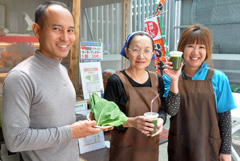
March 31, 2013 Yuuna Fukuhara of Ryukyu Shimpo
Agricultural Production Cooperative Nishihara Farm, which was established in conjunction with Nishihara Town, the Deserted Arable Land Planning Committee, and the Commerce and Industry Association, has worked to expand consumption of locally produced nigana. Nigana is a type of indigenous vegetable containing many nutritional components. However, there have been few applications in cooking except dishes dressed in a white miso sauce or put in soup. Processing Division Manager Jun Arakawa said, “We want to promote nigana as an island vegetable.”
As its name suggests, nigana is a leafy vegetable with a strong bitter taste. However, unlike bitter melon, nigana is not well known, and there are few applications for its processed products. Nigana is very rich in nutrition, containing much Vitamin A for maintaining healthy skin and tissue, Vitamin C for enhancing immunity and collagen formulation, as well as calcium and iron.
Arakawa explains, “People have hesitated to use it because of its name and taste, but it really is very nutritious and can be cultivated throughout the year without using agrichemicals. As a starter from February, at the processed goods store next to the JA Okinawa Nishihara Branch, nigana juice will sell for 100 yen a cup. When it is mixed with 100% pineapple juice, locally produced nigana juice is much easier to drink.
Intending to supply raw materials to beverage manufacturers, Arakawa said, “I would like to promote consumption of this vegetable and make it into a special product of this town.”
For more information, call Nishihara Farm at 098-945-4540.
(English translation by T&CT, Megumi Chibana and Mark Ealey)
Go to Japanese
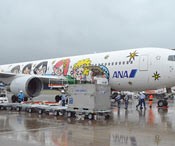
April 1, 2013 Ryukyu Shimpo
On March 31, the first flight using mid-sized aircraft on the Haneda-Ishigaki route operated by All Nippon Airways (ANA) arrived at New Ishigaki Airport. ANA uses the 270-seater Boeing 767-300. Because it can also transport cargo, it is hoped that the aircraft will encourage tourism and the export of local products. This is the first time that ANA is flying on this route in seven years.
New Ishigaki Airport is a recently completed airport equipped with a 2000-meter runway, making it possible for mid-sized aircraft to land and take-off, something not possible at the previous airport. The airport does not have aircraft weight limits and is able to handle direct flights to the Japanese main islands without needing to refuel at other airports.
The first incoming flight and outgoing flights were almost fully booked. The Ishigaki City Tourist Association welcomed passengers with snacks and certificates commemorating their arrival to Japan’s southernmost point.
The outgoing flight carried local products such as okura, bitter melon, flowers and prawns. Previously, cargo had to be flown to Naha using small aircraft before shipping it on to the main islands, but now products can be transported directly to the large market in Tokyo. It is said that this will resolve the issue of leftover pineapples and mangoes during the summer.
(English translation by T&CT, Lima Tokumori and Mark Ealey)
Go to Japanese

April 2, 2013 Ryukyu Shimpo
On April 1, Naha set itself up as the first core city in the prefecture. It becomes the country’s 42nd core city designated in this manner under the Local Autonomy Law of Japan. Core cities assume many roles normally carried out by prefectural governments. Naha has been delegated administrative roles from the Okinawa Prefectural Government for over 2490 matters, including public health centers, physical disability certification and construction permits for nursing homes and nursery centers. Prefectural capital Naha will strengthen the authority of the local government, and citizens hope that their municipal office will provide enhanced services and a pioneering approach as a core city. A ceremony was held at the City Hall from 8:00am, and officials and citizens came together to celebrate the core city status. Governor Hirokazu Nakaima handed over a document to transfer a range of duties to Mayor Takeshi Onaga.
Mayor Onaga said, “This is a day worth commemorating and not just for our city. It represents a major step forward that will lead to growth for all of Okinawa.” Morihiro Nagayama, the chairman of the city council, said, “We want to put forward more policy proposals, including those for urban development appropriate for a core city and beneficial to our citizens. ” Governor Nakaima said, “I want the Naha Core City to open the door on a new era and to lead to the development of the whole region, as a hub city of Asia, not just for Japan.”
When a banner bearing the words, “Congratulations! The Birth of Core City Naha” dropped down from the ceiling, cheers and applause broke out among the participants, including the mayor, governor and representatives of neighborhood community associations and the Council for Town Planning.
Naha Public Healthcare Center held a ceremony to mark its taking over activities from the Prefectural Public Health Center in the afternoon, and has now started its work.
Work related to public health care accounts for 40 percent of all that transferred to the city from the Okinawa Prefectural Government. Hideki Kuniyoshi, the director of the Naha Public Healthcare Center, said, “We aim to become the healthcare center that people can depend on, being quick and adaptable as we approach each task.”
(English translation by T&CT, Mark Ealey)
Go to Japanese
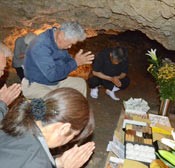
April 1, 2012 Ryukyu Shimpo
In the early stages of the Battle of Okinawa, on April 2, 1945, soon after the U.S. forces landed on the main island, an incident of group suicide (normally referred to in Japanese as shudan jiketsu in which the Japanese military ordered or drove civilians to commit suicide) occurred at Chibichiri- gama in Namihira, Yomitan Village. On March 31, family members of the 83 people who died held a memorial service at the gama, which means natural cave in the Okinawan dialect. About 20 of them gathered and prayed for the repose of the souls of those who died, pledging to strive to create peace. The family members made an offering of fruit and rice cakes at the altar, and lit incense sticks for the victims. Some shed tears as they pressed their hands together in prayer with their eyes closed.
Fifty-eight year-old Norio Yonamine, a member of the Bereaved Families Association, said that this year marks three decades passing since the incident was brought to light. Yonamine said, “My children and grandchildren all grow up. All we can do is tell the truth about what happened and try to prevent war from happening again.”
Seventy year-old Tokuichi Yonamine lost his grandmother and five of his siblings during the battle. After the war, his mother brought him to the gama, where he prayed.
Yonamine said, “My mother used to go out of her way to avoid seeing Chibichiri-gama. I didn’t understand what my mother felt at that time, but I do now.”
(English translation by T&CT, Mark Ealey)
Go to Japanese
April 1, 2013 Sakae Toiyama and Kenyu Uchima of Ryukyu Shimpo
On April 1, six months passed since the U.S. Marine Corps deployed the MV-22 Osprey vertical take-off and landing transport aircraft to U.S. Marine Corps Futenma Air Station. The deployment occurred on October 1 last year based on an agreement with the Japanese government despite strong protests from the Okinawan people. The mayors of all 41 municipalities in Okinawa and the chairmen of the various assemblies have since presented Prime Minister Shizo Abe with a petition requesting that the U.S. and Japanese governments rescind the deployment of the Osprey aircraft. The Okinawan people still strongly oppose the aircraft’s deployment in the prefecture.
While the Marine Corps has begun low-level flight training of the Osprey in the main islands of Japan from March, it is yet to move the training off Okinawa to other prefectures, something which the U.S. and Japanese governments agreed to consider.
In addition to the first squadron of 12 aircraft, the Marines are scheduled to deploy another 12 to Okinawa some time after this July.
The U.S. military is also considering deployment of the CV-22 Osprey, an air-force variant of the MV-22 to Okinawa.
The burden on Okinawa of hosting the U.S. military bases is expected to increase.
In cooperation with the municipalities in Okinawa, the Okinawa Prefectural Government (OPG) has been implementing visual surveys of the flight operation of the Osprey. In its two-month report at the end of last December the OPG stated that 60 percent of the operations, including flights over densely populated areas, violated the agreement reached between the U.S. and Japanese governments. The OPG asked the Okinawa Defense Bureau director Hiroshi Takeda and the head of the Okinawa branch of the Ministry of Foreign Affairs, Haruhisa Takeuchi, to investigate the actual details of the flights and check them against the terms of the agreement. Three months have passed but the central government is yet to respond to the request.
In a press conference held after the cabinet council on March 29, Defense Minister Itsunori Onodera referred to the approximately 320 cases that the OPG has requested the Japanese government to look into as possible violations of the agreement, saying, “We are considering the cases, checking them one by one.” Onodera did not give a clear schedule for completion of this process, saying, “We can’t rush to a conclusion on this.”
Following the deployment of the Osprey to Okinawa, the Okinawa Defense Bureau has conducted visual inspection of flights, taking photographs of the aircraft. By means of a freedom-of-information request, the Ryukyu Shimpo was able to acquire documents regarding the visual inspection data collected by the bureau. The documents cover the locations of the visual inspection and what the aircraft was doing, such as taking off, landing or circling, but they lack information on the Osprey’s flight mode, which is important for verifying whether or not the U.S. Marines have violated the agreement on the Osprey flight operation.
Although the bureau seems to have conducted this verification process using photographs and other data, the reliability of the data and information can be questioned.
A top official of the Ministry of Defense opened up to say, “The U.S. Marines have to abide by the agreement unless operational necessity arises. Under the current conditions, it is difficult for us to point to violations of the agreement if the U.S. military asserts that it is an operational necessity.”
The official claimed that it is difficult to confirm whether or not the U.S. military is actually abiding by the agreement, saying, “It is easy to confirm clear violations, but (over the U.S. military bases) it is really difficult for us to tell if the Osprey is flying in helicopter mode or conversion mode.” In that it hinges on the discretion of the U.S. military, it is clear that the agreement reached between the U.S. and Japanese governments is limited in terms of securing the safety of Osprey operations.
At the same time, there are no developments to ease Okinawa’s burden of hosting the U.S. military bases.
In the plenary session of the House of Councilors held on April 6, Prime Minister Abe mentioned the Osprey operations, saying, “The basic premise is give maximum consideration to the lives of local residents.” But at the same time, Onodera explained that there has been no clear development with regard to transferring the Osprey training off Okinawa to other locations in the main islands of Japan. This has been agreed upon between the U.S. and Japanese governments, but Onodera said, “We are asking the U.S. government to quickly decide upon a policy for this, but they have not provided us with a clear schedule.”
The Japanese government will seek to negotiate the transfer of the Osprey training with the U.S. government.
Negotiations with the various local governments that would host the training do not seem to be going smoothly because some of them are concerned about the safety of the Osprey.
(English translation by T&CT, Mark Ealey)
Go to Japanese
April 6, 2013 Ryukyu Shimpo
Maybe this is just a strategy to maintain the burden of bases on Okinawa. The plan does not talk of even one single military base being moved outside of the prefecture. Why don’t the governments of Japan and the United States realize that their forcing even greater sacrifice on Okinawa has become untenable? The governments have announced a return and integration plan to give back land currently used for the five facilities located south of Kadena. On this occasion they have only presented the timetable because back in 2005 they announced that they would return these five bases. This is simply a ploy to manipulate public opinion and to deceive people who do not know about the processes within the Okinawa base issue. They present this as though it were proof of the Abe administration striving to reduce the burden on Okinawa. In the past, other plans that place U.S. bases only in Okinawa have failed repeatedly, so they should learn from past failures.
Governments to build new bases to replace unused facilities
There are many points in this plan that can only make us shake our heads in disbelief. The Makiminato Service Area will be returned under the condition that the government builds replacement facilities for its warehouses at Torii Station, Kadena Ammunition Depot and Camp Hansen. So in effect, it is developing U.S. bases by building new warehouses in these three other locations. The return of Naha Port is scheduled to occur sometime in or after fiscal 2028.
Why should it take 15 years to return a base that has hardly ever been used? The condition for the return of Camp Kuwae (Camp Lester) is that it happen once the Naval Hospital has been relocated to Camp Zukeran, but the hospital has already moved and is up and running, so the Navy should be able to return it now. What is the logic behind the timing of a return in 2025 or beyond? There are many other similar examples, including the conditions for the return of part of Camp Zukeran.
The agreement only states that each facility will be returned in or after a certain fiscal year, so rather than being a plan for the return of these bases, it is best described as a plan to postpone their return.
Last month, in a program on the Public Broadcasting Service, Chairman of the Senate Committee on Armed Services, Carl Levin, called for the reduction of the number of U.S. troops stationed overseas. He said that U.S. forces deployed in the Pacific region, and especially in Okinawa, should return to the United States. It is said that the operational significance of the Marine Corps, which is a conventional force designed for amphibious warfare on a large scale, has long since faded. The Corps’ rapid deployment capability has improved significantly due to developments in military technology. The Marines could just as well be based in America as a force specializing in a small-scale conflict, and could be dispatched from there with the necessary equipment and personnel in response to any conflicts that may occur. Considering the serious financial difficulties that the United States currently finds itself in, this is surely the option that the Marines should pursue. In this context, we cannot understand why the governments are trying to build a new base and keep the Marines on Okinawa. Some prominent people in the United States even say that there is no longer any need for the Marine Corps to exist.
In the new consolidation plan for U.S. bases in Okinawa the return of Futenma Air Station has been put off until fiscal 2022 or beyond. In the SACO agreement (Japan-U.S. Special Action Committee) concluded between Japan and the United States in 1996 this facility was scheduled to be returned in 2003. Then in 2006 the timing for the return changed again to 2014 as part of the Realignment of U.S.
Forces, and this latest announcement pushes it back even further. On top of this, once again the governments have made this subject to the construction of an alternative facility within the prefecture. This can only be described as the unpardonable forcing of further sacrifices on Okinawa.
The concept of “Making Okinawa catch up with the mainland” was nothing but an illusion.
With regard to the reduction of numbers of U.S. troops, Okinawa and the main islands of Japan have been treated differently right from the start. During the period when Okinawa was under U.S. occupation the U.S. bases in the main islands of Japan were drastically reduced in scale, but they were concentrated on Okinawa.
The Marine Corps moving to Okinawa from the main islands of Japan is one example of this.
U.S. military bases in the Tokyo metropolitan area were integrated to Yokota in 1968 in what is known as the “Kanto Plan.” Looking at the period since 1972, the year that Okinawa reverted to Japanese sovereignty, while the U.S. bases in the main islands of Japan have decreased by about 59 percent in scale, on Okinawa they have only decreased by about 19 percent. The Japanese government promised “a nuclear-free, mainland-level status” for Okinawa when it negotiated with the United States on the Okinawa Reversion Treaty, but the status of Okinawa is yet to reach the level of that of the main islands of Japan.
The governments came up with the SACO Agreement in response to the Okinawan people demanding that these differences between their prefecture and the rest of Japan be resolved. However, with regard to the return of the Makiminato Service Area, Futenma Air Station and Naha Port, the governments have stated that the facilities must be relocated within the prefecture. With this as the sticking point, the return of these bases is yet to be realized.
The Abe administration is working to persuade the governor of Okinawa and the mayors of the municipalities to accept the content of the U.S. Forces Realignment Plan. Sending a string of ministers to Okinawa, the administration has put forward various attractive measures to help develop the prefecture. The Abe government seems to be following the track of the success in 1997 in getting the Okinawan governor to agree to relocate the Futenma base within the prefecture, but they do not seem to realize that there is a crucial difference between now and the past. The Okinawan people now know that the central government’s policy has made their lives miserable, and that that is the result of discrimination. The Okinawan people will never return to the point where they will accept this discrimination.
Even when in the past the governor agreed to the relocation within the prefecture, in a public opinion poll the majority of people objected to the government’s plan of relocating the Futenma base within Okinawa. The bases will not be returned as long as the government sticks to its stance of relocation within the prefecture. The government should come to grips with the lessons from the past.
(English translation by T&CT, Mark Ealey)
Go to Japanese

March 29, 2013 Yoko Takaesu of Ryukyu Shimpo
On March 28, Okinawa University announced that it has set up a special bursary for foster-care students who need assistance. All tuition fees will be waived for these students for four years. Starting from next April, a limited number of enrollees who pass the university’s special admission exam are eligible.
This is the first waiver of this type among Okinawa’s public and private universities. Outside Okinawa, the Yamaguchi University of Human Welfare and Culture in Yamaguchi has a similar bursary program, but the waiver of tuition fees is only for two years. According to Okinawa University, a full waiver of tuition fees for four years is rare in Japan.
The Okinawa Foster Parent Association and personnel of foster care facilities appreciate this program, and they expressed their desire that other universities will following Okinawa University’s example, and set up such programs.
Under the Child Welfare Act, children living in foster care facilities and foster children will no longer need to be under the care of a foster-care facility or foster parents upon graduation from high school.
It is said many children have to give up on hopes of progressing to higher education because they are unable to afford it. In addition, a study carried out by the Okinawa Children’s Welfare Council in 2005 indicated that 46% of children in foster care facilities in Kyushu and Okinawa who went on to higher education eventually dropped out citing hardship, and even those presently enrolled found the cost of tuition to be a problem.
The president of Okinawa University, Akihiko Kato, stated, “I wanted to respond to the needs of students who wanted to learn in their difficult circumstances. It helps other students around them to understand another side of society.”
Applicants must have a recommendation from a foster care facility or the like, and one from their high school principal stating that they are capable of maintaining good results for the four years. To continue receiving the bursary successful applicants are required to take 30 or more credits a year and have a GPA of 2.5 or above after the second year.
Kiyohiko Toyama, the head of the Okinawa Foster Parent Association, said, “There have been many cases of foster parents bearing the expenses of higher education for their foster children. I’m very happy to hear about this waiver of tuition fees. This will serve as motivation for the children and give foster parents the confidence to encourage them towards higher education.”
Choki Shimabukuro, the head of the Okinawa Children’s Welfare Council, stated, “This has been a long-sought after program because there have been many children who have given up on their dream of higher education. I thank Okinawa University for what they have done. I hope that other universities will start similar programs so children can continue pursuing their dreams.”
Okinawa University’s welfare special fees waiver for foster care students
[Application Requirements]
・To be in a foster care facility or foster home
・Recommendation from the head of the facility
・Have difficulty paying tuition fees
・Take the special admission examination for Okinawa University
・Recommendation from high school principal stating that they can maintain good results for the four years
[A limited number of applicants will be accepted]
(English translation by T&CT, Lima Tokumori and Mark Ealey)
Go to Japanese
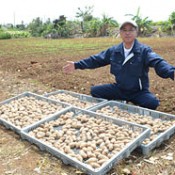
March 28, 2013 Maki Nagamine of Ryukyu Shimpo
The Ryukyu Eco Project, a farming corporation in Nago, is increasing its production of the lesser yam, which is called kuga-imo in the Okinawan dialect. The yam is rich in nutrition, but because of the difficulty in harvesting and distributing it its annual production volume in the prefecture is less than ten tons. This tropical plant has been eaten for more than a thousand years only in Okinawa. In its first year of production, the farming corporation will produce more than 10 tons in about 10000 square meters of the agricultural land that they own in Nakijin. The corporation is marketing the kuga-imo as a brand product, making processed goods with the yam. Ministry of Agriculture, Forestry and Fisheries is promoting the sixth industry approach in which people engaged in agriculture, forestry, and fisheries take part in processing goods and distribution.
Kuga means egg in the Okinawan dialect. The lesser yam was named as such from the fact that it is similar to an egg in shape. Some research results suggest that kuga-imo contains about 200 times the amount of diosgenin than other varieties of yams, which helps recovery from fatigue and mitigates the debilitating effects of the summer heat. However, there are few growers of the lesser yam, because it has small thorn vine roots, which makes it hard to harvest. What is worse is that is difficult to distribute, because it spoils easily if it is scratched. From last December, the company has purchased about 300 kilograms of seed tubers from individual farmers and greengrocers in Okinawa. They will plant the seeds in early April and will harvest the crop from December to next February. They plan to use about one ton of the first-year production as seed tubers for the following fiscal year to expand the production volume each year.
The Ryukyu Eco Project is currently arranging the supply system for its products. At the same time, it is working on creating sweets in collaboration with the Ryukyu Dolce Terrace, a Tomigusuku based shop that manufactures and sells confectionery utilizing Okinawan materials and ingredients. It plans to build a processing facility in Nakijin, with a retail store to promote to sell the products.
Kazuo Asato, director of the farming corporation, said, “We want to compete as products grown only in Okinawa, looking for a way to differentiate ourselves from other prefectures. We have to revive our traditional farm products to become a kuga-imo-producing region. We intend to sell our products outside the prefecture and to foreign countries.”
(English translation by T&CT, Mark Ealey)
Go to Japanese
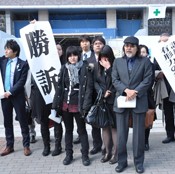
March 30, 2013 Tatsuya Ikeda of Ryukyu Shimpo
The plaintiffs have won approximately 65 million yen in a lawsuit concerning the death of 20 year-old Eikichi Shimabukuro, who was killed in 2006 in hand-to-hand combat training at Camp Makomanai in Sapporo, Hokkaido.
The Sapporo District Court ruled on the case on March 29. The plaintiffs, the parents of Shimabukuro, a private first-class in the Self Defense Force and originally from Okinawa, claimed about 92 million yen from the government. Presiding Judge Shunichi Ishibashi agreed that the instructor overseeing the training had failed in his duty to provide proper supervision.

Outline of the ruling.
The ruling acknowledged the instructor’s culpability, saying, “The instructor threw Shimabukuro, who was at a lower level of the scale in terms of his ability to cope with the throw, despite being aware of the possible danger that Shimabukuro could hit his head on the ground.”
At the same time, the judge dismissed the plaintiff’s claim for hazing, saying, “It would seem that Shimabukuro suffered injuries during training and medical treatment.” Shimabukuro’s parents suspect that the multiple injuries over his body were the result of bullying or hazing that exceeded the bounds of regular training.
With regard to hand to hand combat, the judge said, “It is a combat technique designed to hurt or kill someone. There is inherent risk involved in such activities.”
The plaintiff’s attorneys saw the ruling as groundbreaking, saying, “It was the first time that a court has made a ruling like this on such training.”
Following the ruling, Shimabukuro’s father, Tsutomu, said, “Although the case had been dragged into the shadows, through this trial I think that we have managed to make my son’s existence even more significant.”
A representative of the Ministry of Defense said, “In some respects we were unable to get the presiding judge to understand the situation. After carefully going through the ruling, we will talk to the institutions concerned, and deal with the situation.”
(English translation by T&CT, Mark Ealey)
Go to Japanese

March 25, 2013 Ryukyu Shimpo
On March 24, closing ceremonies were held at Genga Elementary School and kindergarten in Nago, and Kori Elementary School and kindergarten in Nakijin. Decreasing numbers of pupils mean that they will merge with neighboring schools from April. Genga Elementary School has operated for 68 years, and Kori Elementary School for 122 years.
Participants said heartfelt farewells to their old schools.
More than 500 local residents, including people from Naha and other regions, attended the ceremony at Genga Elementary School. Twenty-one pupils and two young children said that they will keep the traditions of the school in their hearts and their memories, and that Genga Elementary School was a marvelous place to study.
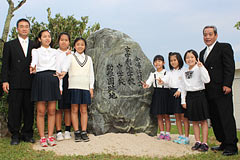
On March 24, pupils at Kori Elementary School unveiled a memorial stone at Kori Elementary School in Nakijin.
About 300 local residents and former pupils took part in the closing ceremony at Kori Elementary School. Everyone sang the school song after they unveiled a memorial stone in the school grounds.
Sixth grader Dona Matsuda said, “I will never forget the school that I attended for eight years, right through from kindergarten. When I eventually have a family, I’ll show them the memorial and will tell them where my school was.”
Genga Elementary School will merge with Makiya Elementary School and Kori Elementary School will merge with Amesoko Elementary School.
(English translation by T&CT, Hitomi Shinzato and Mark Ealey)
Go to Japanese
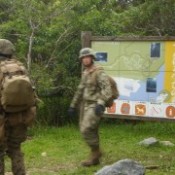
March 27, 2013 Ryukyu Shimpo
It has been confirmed that at around 4:30pm on March 26, more than a dozen U.S. soldiers walked on a track in the Yambaru Discovery Forest in Aha in Nago. According to the manager of the facility, Yasuo Yamakawa, who witnessed the scene, they entered the facility from the area near the walking trail and departed towards Aha Dam. They did not seem to be carrying firearms. “This is not a military training area. U.S. soldiers should not be allowed to come here like this,” Yamakawa said.
They were wearing camouflage fatigues and combat helmets and carried military backpacks. At the time, there were about 30 people, including elementary school pupils and tourists, taking part in a camp program, and some of them walked past the soldiers.
The Yambaru Discovery Forest is surrounded by the U.S. military Northern Training Area. At around 12:30am, a staff member of the facility saw an Osprey aircraft training at the helicopter landing zone LZ4 near the forest, and the soldiers in question are thought to have disembarked from that aircraft.
(English translation by T&CT, Lima Tokumori and Mark Ealey)
Go to Japanese











 Webcam(Kokusai Street)
Webcam(Kokusai Street)


